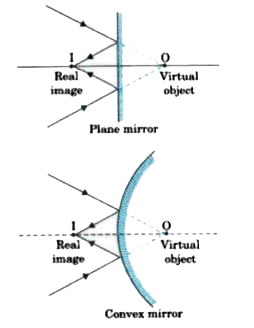Answer the following questions :
Does the apparent depth of a tank of water change if viewed obliquely ? If so, does the apparent depth increase or decrease ?
(a) Real images can be produced by plane and convex mirrors. When the rays that are converging to a point behind a plane or convex mirror are reflected to a point in front of the mirror on the screen, the image formed will be real. This is the case of a virtual object. In case of convex mirror if the converging rays tend to converge at focus or beyond focus then they will not be able to form the real image after reflection.

(b) Virtual image is formed when the reflected or refracted rays are divergent. The divergent rays can be converged on to a point with the help of an appropriate converging lens. The convex lens of the eye serves the same purpose. The virtual image here serves as an object for the lens to produce a real image on the retina. Hence, there is no contradiction.
(c) The rays starting from the head of the fisherman and incident on water become bent towards normal and appear to come from a higher point. So fisherman looks taller.
(d) The apparent depth of tank when viewed obliquely decreases from its value for near- normal viewing. This is due to the phenomenon of refraction of light.
(e) Refractive index of diamond is about 2.42, that is much larger than that of ordinary glass for which refractive index is about 1.5. Using,
sinic=1μ
The critical angle for diamond is about 24∘, and that for glass is 42∘. A skilled diamond cutter utilises the large range of angles of incidence in the diamond, from 24∘ to 90∘, to ensure that light entering the diamond is totally reflected from many faces before getting out. In this way, light entering the diamond produces a sparkling effect.
Topper's Solved these Questions
- BOOK - MODERN PUBLICATIONCHAPTER - RAY OPTICS AND OPTICAL INSTRUMENTSEXERCISE - NCERT (EXemplar Problems Obejective Questions) (Multiple Choice Questions (Type-I)10videos
RAY OPTICS AND OPTICAL INSTRUMENTS
- BOOK - MODERN PUBLICATIONCHAPTER - RAY OPTICS AND OPTICAL INSTRUMENTSEXERCISE - NCERT (EXemplar Problems Obejective Questions) (Multiple Choice Questions (Type-II)6videos
RAY OPTICS AND OPTICAL INSTRUMENTS
- BOOK - MODERN PUBLICATIONCHAPTER - RAY OPTICS AND OPTICAL INSTRUMENTSEXERCISE - Tough & Tricky (PROBLEMS)20videos
RAY OPTICS AND OPTICAL INSTRUMENTS
- BOOK - MODERN PUBLICATIONCHAPTER - NUCLEIEXERCISE - CHAPTER PRACTICE TEST FOR BOARD EXAMINATION15videos
NUCLEI
- BOOK - MODERN PUBLICATIONCHAPTER - SEMICONDUCTOR ELECTRONICS METERIALS DEVICES AND SIMPLE CIRCUITS EXERCISE - CHAPTER PRACTICE TEST FOR BOARD EXAMINATION12videos
SEMICONDUCTOR ELECTRONICS METERIALS DEVICES AND SIMPLE CIRCUITS
Similar Questions
Answer the following questions :
Does the apparent depth of a tank of water change if viewed obliquely ? If so, does the apparent depth increase or decrease ?View SolutionAnswer the following questions :
(a) You have learnt that plane and convex mirrors produce virtual images of objects. Can they produce real images under some circumstances ? Explain.
(b) A virtual image, we always say, cannot be caught on a screen. Yet when we 'see' a virtual image, we are obviously bringing it on to the 'screen' (i.e., the retina) of our eye. Is there a contradiction ?
(c) A diver under water, looks obliquely at a fisherman standing on the bank of a lake. Would the fisherman look taller or shorter to the diver than what he actually is ?
(d) Does the apparent depth of a tank of water change if viewed obliquely ? If so, does the apparent depth increase or decrease ?
(e) The refractive index of diamond is much greater than that of ordinary glass. Is this fact of some use to a diamond cutter ?View Solution
Knowledge Check
- Question 1 - Select One
A : The apparent depth of a tank of water decreases if viewed obliquely.
R : Real depth decreases if viewed obliquely.AIf both Assertion & Reason are true and the reason is the correct explanation of the assertion, then mark (1).BIf both Assertion & Reason are true but the reason is not the correct explanation of the assertion, then mark (2).CIf Assertion is true statement but Reason is false, then mark (3).DIf both Assertion and Reason are false statements, then mark (4). - Question 2 - Select One
In which of the following reaction does the heat change represent the heat of formation of water ?
A2H2(g)+O2(g)→2H2O(l),ΔH=−116kcalBH2(g)+12O2(g)→H2O(l),ΔH=−58kcalCH+(aq.)+OH−(aq.)→2H2O(l),ΔH=−13.7kcalDC2H2(g)+212O2(g)→2CO2(g)+H2O(l),ΔH=−310kcal - Question 3 - Select One
In which of the following reaction does the heat change represent the heat of formation of water ?
A2H2(g)+O2(g)→2H2O(l),ΔH=116KcalBH2(g)+12O2(g)→H2O(l),ΔH=−6.8KcalCH+(aq)+OH−(aq)→H2O(l),ΔH=13.7KcalDC2H2(g)+2O2(g)+H2O(l),ΔH=310Kcal
Answer the following questions :
(a) You have learnt that plane and convex mirrors produce virtual images of objects. Can they produce real images under some circumstances ? Explain.
(b) A virtual image, we always say, cannot be caught on a screen. Yet when we see a virtual image, we bring it to screen i.e. retine of our eye. Is there a contradiction ?
( c) A diver under water looks obliquely at a fisherman standing on the bank of a lake. Would the fisherman look taller or shorter than what he actually is ?
(d) Does the apparent depth of a tank of water change if viewed obliquely ? If so, does the apparent depth increase or decrease ?
( e) The refractive index of diamond is much greater than that of ordinary glass. Is this fact of some use to a diamond cutter ?View SolutionAnswer the following questions.
Does it represent a prokaryotic cell or an eukaryotic cell?View SolutionHow does the density of sea water change with depth?
View SolutionAnswer the following questions.
What gives a perception of depth or three dimensional vision to human eye?View SolutionIf the real depth of a coin in water (μ = 4/3) is 4 cm, the apparent depth is
View Solution
